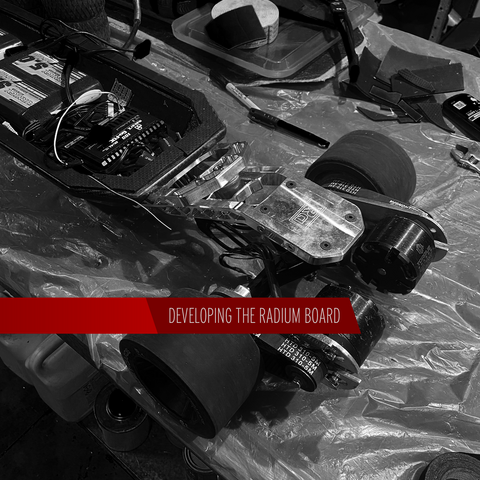In the last update we made the carbon fiber parts of our prototype electric skateboard, but we cant test it until we’ve made a new suspension system since this is an integral part of our board which connects the trucks to the carbon fiber battery enclosure that carries all of the weight, unlike most boards where the trucks are mounted to the deck.
The lessons learned from the first successful push board prototype were applied to the new electric suspension design and after a week of creating the milling tool paths and tedious machining it was finally ready to put to the test:



An immediate issue was that the deck was sitting too high above the trucks so we ended up making new suspension arms that dropped the deck down lower.


We were really excited at this point and the first test ride as a push board was very promising!
Check out the first test ride here – https://youtu.be/OTZybAHkA4k
An issue noticed while riding was a lot of fine vibration resonating through the stiff enclosure like an acoustic guitar chamber, so we added 9kg of steel weights to simulate a battery and electronics which saw that issue disappear entirely.

To make sure there was no immediate design flaw we rode the board off a 1ft ledge around 10 times with the steel weights which appeared to be no problem so we proceeded to electrify it.
Watch that test here – https://youtu.be/_graBY9akJ8
A small 5Ah 12S Li-Po pack and MakerX DV6 motor controller were initially used with some old Torqueboards 6355 motors, Torqueboards 218mm Caliber based trucks and an old set of our first gen motor mounts.



This board was named “XP1” for experimental prototype 1, and despite having a range of only 10km this thing was awesome. We were really happy with the feel of the deck and the way it felt to ride considering the primitive trucks that were on it.
Much experimentation was done with different bushings for the suspension (since regular skateboard bushings are used). Changing the duro, shape and formula of the bushings all have an impact on the way the board rides. A softer setup feels more attached to the road but more floaty and “lazy” handling. Taking the bushings out completely and replacing them with solid plastic to simulate not having any suspension creates a harsh, unpleasant and jumpy ride considering how rigid the whole chassis is. Personally I find the sweet spot to be in the middle with tall cone bushings that provide a nice linear compression, and then I just tighten or loosen the nut if I’m finding a particular trail too bouncy for example. It was certainly very interesting to play with and had me always very excited to go for a ride after tweaking something.
In the next update we make upgrades, build XP2 and iron out all sorts of issues.


